Last updated on November 7th, 2023 at 11:51 am

- Genu varum, also known as bow-leggedness, is a condition in which the legs curve outward at the knees while the ankles and feet are together.
- It is a common condition that can affect people of all ages, but it is most commonly seen in children.
- Genu varum can be caused by a variety of factors, including genetics, bone disorders, and nutritional deficiencies.
- The condition can lead to problems with walking, standing, and balance, and in severe cases, it may require medical intervention.
- Treatment options for genu varum include exercises, braces, and surgery, depending on the severity of the condition.
- With proper treatment and care, most people with genu varum can lead normal, healthy lives.
Bow leg exercise is perhaps the important option to correct genu varum. Genu varum, which is also commonly called bow leg, in which our leg curves outward, bow outward. When it curves inwards, it is termed a knock knee. Most bow leg cases develop since birth, but some cases are secondary to knee osteoarthritis or rheumatoid arthritis.
Fortunately, we can manage it with some simple stretching and strengthening exercises. Whatever exercises we will learn in this article will be most beneficial to one who has had this disability since childhood. Others can also perform these exercises to prevent further progression of genu valgum. If you have a complaint about bow leg, then read this article till the end.
- How do you Fix Bow Legs?
- Easy genu varum exercises
- Stretching exercises for genu varum
- 1) Hamstring stretching in long sitting for genu varum
- 2) Adductor stretching in long sitting
- 3) Adductor stretching with feet together in butterfly pose (1)
- 4) Adductor stretching with feet together (2)
- 5) Adductor stretching in Figure of 4 position.
- 6) Hamstring stretching in Figure of 4 position.
- 7) Hamstring physiotherapy stretching in long sitting for genu varum
- 8) Hamstring stretching in standing to straighten bow leg
- Bow leg strengthening exercise.
- Final words
How do you Fix Bow Legs?
Genu varum can be corrected either by non-surgical or surgical techniques. Non-surgical therapies include stretching, elastic band exercise, sling exercise, walking traction, muscle resistance exercise, chiropractic, and wearing corrective apparatus. Stretching and elastic band exercises, among the non-surgical treatments, are interventions that are easy to access1.
Let me tell you an exciting thing related to bow legs: we all had bow legs in childhood for two years. This is because when the baby is in the womb, the position of the legs of the fetus is in such a way that the hip is flexed, remains abducted, externally rotated, and the knee flexed in our lower leg2. And the leg remains internally rotated.

So, due to this fetus’s position during pregnancy, when the child is born, the leg remains bow during infancy & childhood. As the child becomes one and a half or two years old, the legs gradually become straight. But, when the bow leg does not get better with time and age, it is a matter of concern; you should consult your doctor immediately.
Easy genu varum exercises
There are two groups of exercises, and we will couple all the exercises under these two subheadings. These two groups of exercises are stretching and strengthening exercises.
Stretching exercises for genu varum
So first, we start with stretching exercises. We will focus on stretching two muscles to correct the genu varum. One is the hamstring muscle, which lies on the back of the thigh, and then its adductor muscle is located on the inner side. So first, we will do stretching of the hamstring muscle.
1) Hamstring stretching in long sitting for genu varum
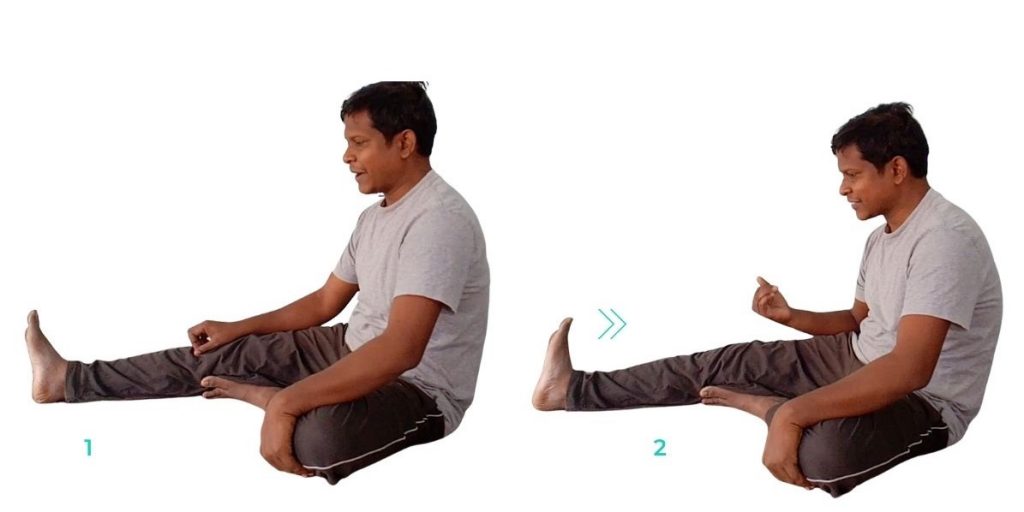
This stretching exercise is performed in a long sitting position.
- Sit up straight in a long sitting position and bend one knee as in the figure, and the other knee will be straight.
- You have to perform this exercise on the straight leg. Start by bending your ankle to move the foot towards yourself and point your toes towards yourself to create a comfortable stretch in the back thigh.
- To make the exercise more effective, sit upright and slowly bend forward.
- Hold this position for at least one minute before relaxing.
- Repeat this process twice on one leg and then switch to the other leg.
- You can also repeat this process three times on the other leg to achieve optimal results.
2) Adductor stretching in long sitting
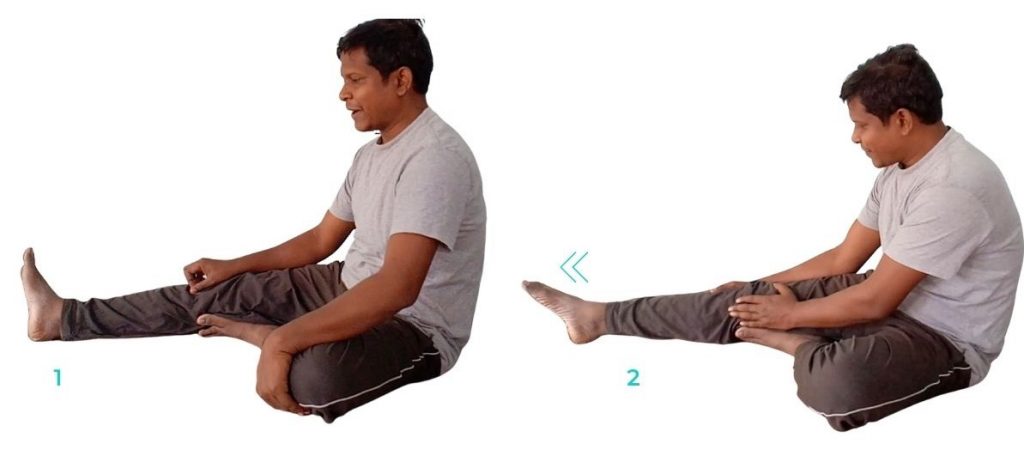
For our next exercise to fix bow legs, we’ll stretch the hip adductor. It’s pretty easy, and you can do it in a long sitting position.
- Sit in a long sitting position, keeping the straight leg to be exercised and bend the other leg as shown in the figure.
- In this position, bend your ankle and toes forward, away from your body.
- Hold it for a minute, and then relax.
- You’ll need to do this three times in a session, holding each time for a minute.
- This stretch is great for the adductor muscles, which are inside our thighs.
3) Adductor stretching with feet together in butterfly pose (1)
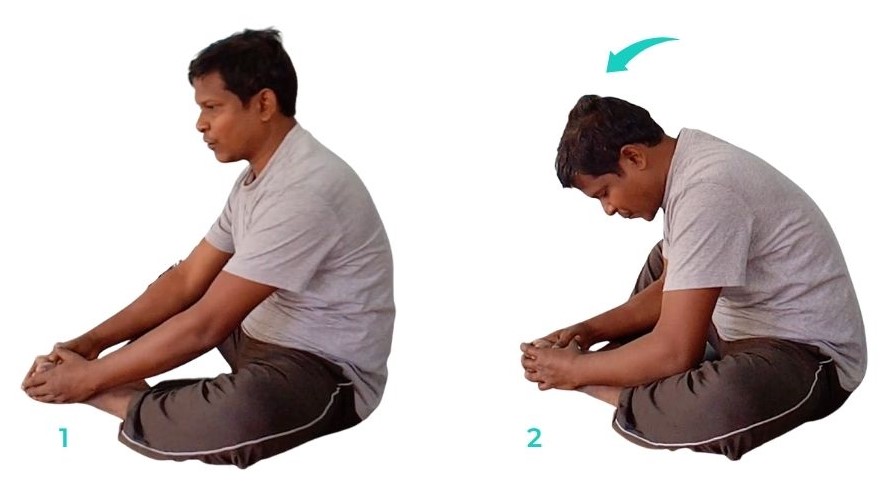
Butterfly pose, also known as Baddha Konasana, is a seated yoga posture that helps to stretch the inner thighs, groin, and knees. To perform this pose:
- Begin by sitting on the floor with your legs extended in front of you.
- Then, bend the knees and bring the soles of the feet together, letting the knees fall to the sides.
- Gently bring the heels towards the pelvis, keeping the outer edges of the feet on the floor. Clasp the hands around the feet and fold forward from the hips, keeping the spine straight.
- This creates a nice comfortable stretch on the inner thigh muscle known as the adductor muscles.
- To make it more effective, sit up straight and slowly bend forward. Try to take your thigh as low as possible, keep the knees down and hold it for one minute.
- Repeat it for 3 to 4 repetitions in a session.
This pose is a great way to stretch the hips and thighs and can also help to relieve menstrual cramps and digestive discomfort.
4) Adductor stretching with feet together (2)
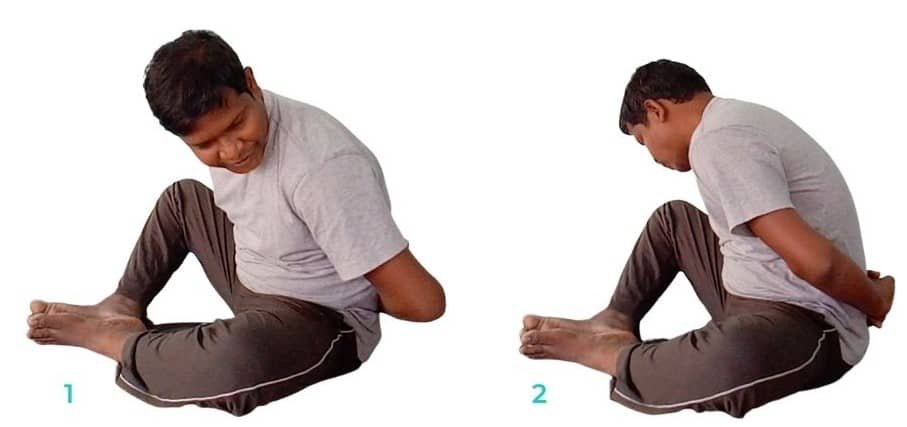
The next exercise is also the stretching exercise of the adductor muscles. This exercise is also performed in butterfly pose as in the previous exercise.
- Sit in the butterfly pose.
- Clasp your hands behind your back.
- In this position, you have to bend yourself obliquity to the left and right side. Observe the figure that my shoulder is bending slightly towards the opposite knee.
- Hold this position for one minute.
- Do it three times in a session.
5) Adductor stretching in Figure of 4 position.
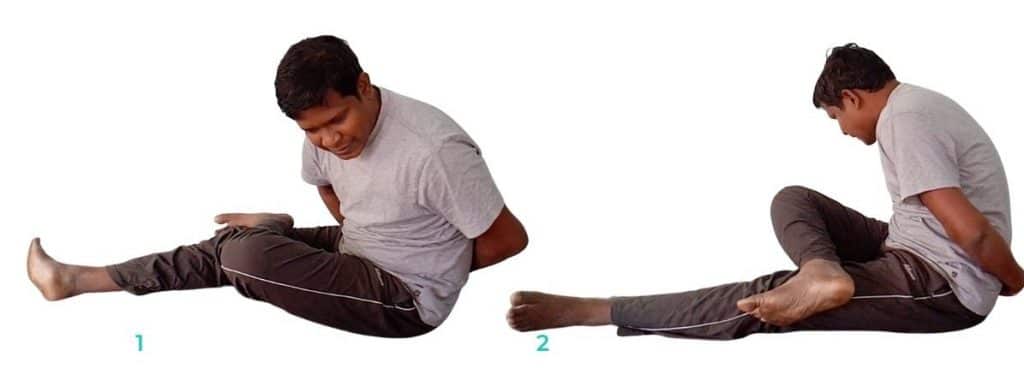
The figure of 4 exercise is a stretching exercise that primarily targets the glutes and hips. To perform this exercise:
- Sit in a long sitting position on a mat. Cross your left ankle over your right knee so your left leg forms a “4” shape.
- Then, clas your hands behind your back and bend forward obliquely towards the left knee direction.
- Hold this position for 15-30 seconds, then release and switch sides.
- Repeat for 2-3 sets on each side.
This exercise can help improve flexibility and mobility in the hips, as well as alleviate lower back pain and discomfort.
6) Hamstring stretching in Figure of 4 position.
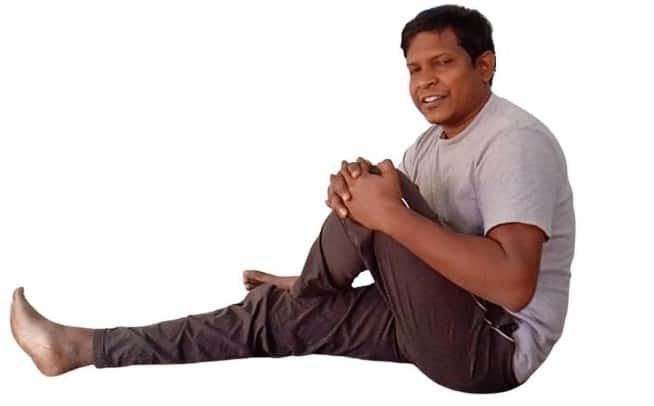
The next stretching exercise is also hamstring stretching, but in the same position, you have to do the figure of 4 positions.
In this position, grab your knee with your hand and then you pull it towards your chest. Hold it for a minute, and then relax. Then, do the same process in the other leg; in the same way, hold it for one minute and repeat it at least three times in a session.
7) Hamstring physiotherapy stretching in long sitting for genu varum
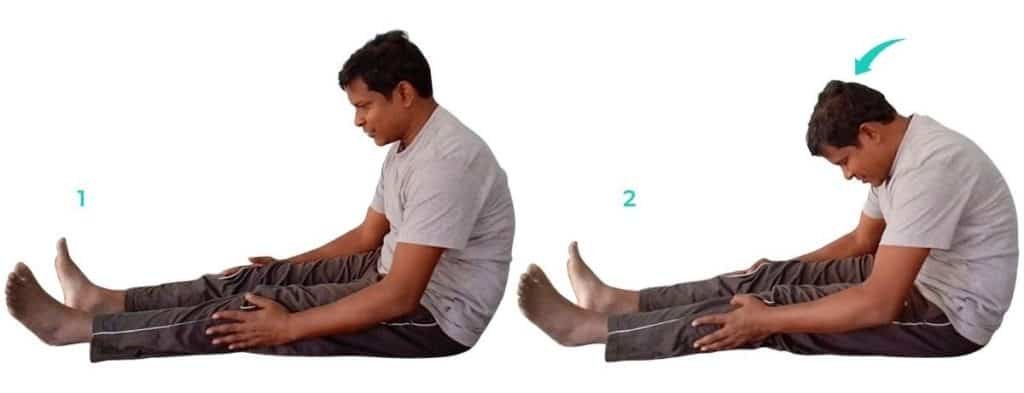
- To perform hamstring exercises, sit on the floor with your legs stretched out straight in front of you.
- Slowly bend forward at your waist, reaching for your toes. You should feel a stretch in the back of your thighs.
- Hold this position for a minute, then relax.
- Repeat this movement three times in one session.
8) Hamstring stretching in standing to straighten bow leg
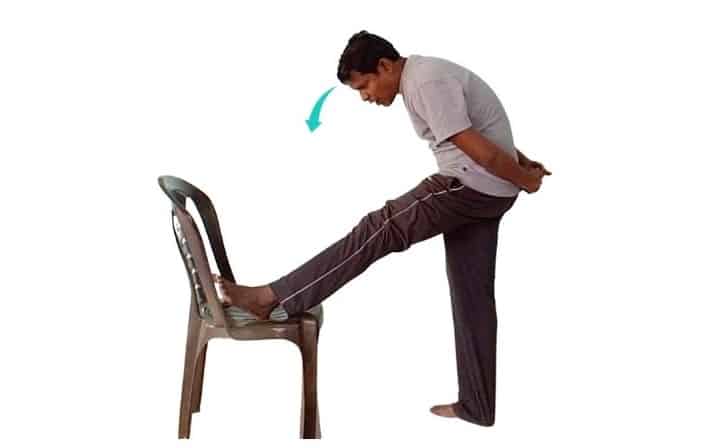
To do hamstring exercises while standing, simply place a chair in front of you.
- For example, if you want to stretch the hamstring of your left leg, place it on the chair and then place your hands backwards.
- Now, bend forward until you feel a stretch.
- Hold this position for at least one minute before relaxing.
- Repeat the exercise on your other leg and return to the starting position.
- It is recommended to repeat this exercise at least three times in a row.
Bow leg strengthening exercise.
So, whatever exercise we are going to do, we will do it with the help of the resistance band. This is a rubber band that gives resistance, it is from Dyna company.
9) Strengthening exercises in side-lying for curved leg
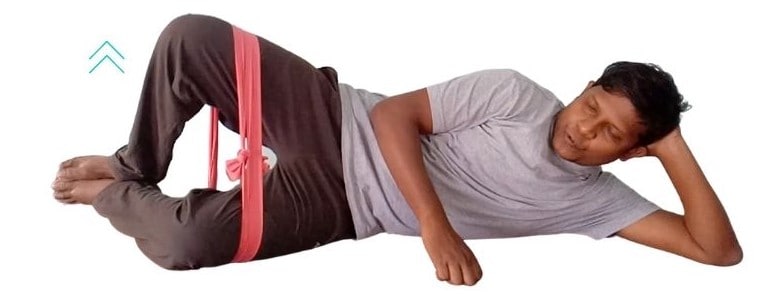
This strengthening exercise is performed in a side-lying position.
- Come to a side-lying position and keep both knees slightly bent.
- To exercise, you need to start by tying a resistance band or theraband to both of your legs. It would help if you tied it around both thighs as demonstrated.
- After tying, lie on your side and tighten the strap as needed.
- Keep both feet together and slowly lift your knee against the resistance of the band, as shown in the figure.
- Hold this position for 5 seconds, counting 1-2-3-4-5.
- Repeat this exercise at least 15-20 times per leg.
- Then, repeat the same process for the other leg.
This is a great strengthening exercise. Let’s move on to the next one.
10) Strengthening exercises in squatting for crooked leg
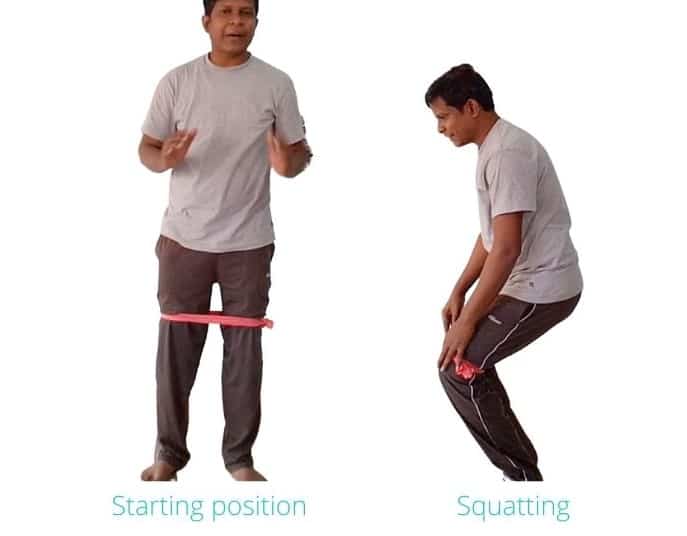
Our next genu varum exercise is a strengthening exercise in squatting.
- Wrap the resistance band around both legs just above the knees and stand with your feet shoulder-width apart.
- Squat down by bending your knees and pushing your hips back as if you’re sitting in a chair. Keep your back straight and your chest up.
- As you squat down, push your knees out against the resistance of the band.
- Pause at the bottom of the squat, then push through your heels and stand back up to the starting position.
- Repeat for the desired number of repetitions, keeping the band tense throughout the movement.
This exercise targets your glutes, quads, and hip muscles, and can help improve your overall lower body strength and stability. It’s a great addition to any lower body workout routine.
11) Lunge exercise for bow leg
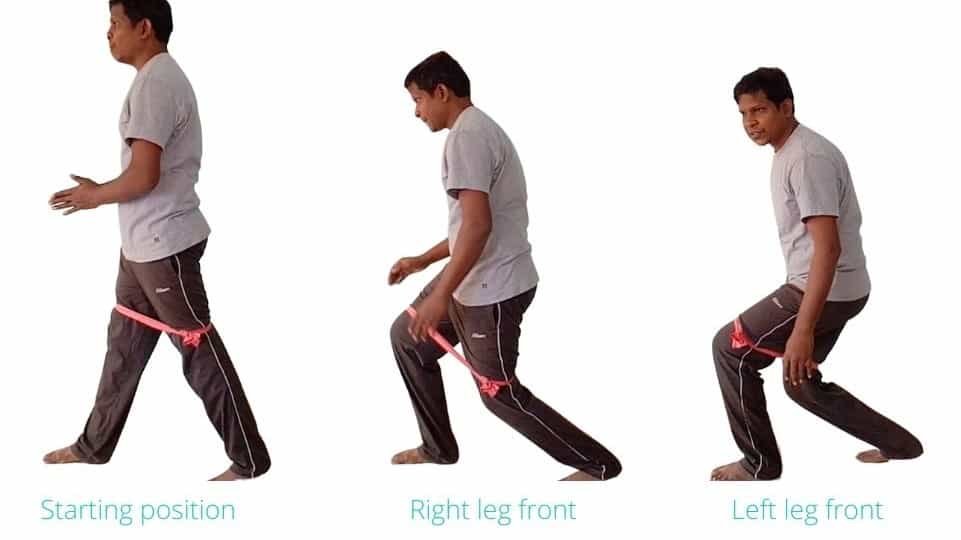
To perform the lung exercise with a resistance band tied at knee level, follow the steps below:
- Begin by standing with your feet shoulder-width apart and the resistance band tied around your legs, just above your knees.
- Take a step forward with your right foot and lower your body into a lunge position, keeping your left foot in place.
- As you lower your body, ensure your right knee is above your ankle. Your left knee is hovering just above the ground.
- Push through your right heel to return to the starting position, squeezing your glutes and engaging your core as you stand up.
- Repeat the same movement on the other side by stepping forward with your left foot.
- Continue alternating sides for the desired number of repetitions or times.
This exercise is great for strengthening your lower body muscles, especially your quads, hamstrings, and glutes. The resistance band adds an extra challenge to the exercise, making it more effective in building strength and toning your muscles.
Final words
Exercises for genu varum can be effective for correcting this condition and improving overall lower body strength and stability. However, it is important to work with a qualified healthcare professional to determine the specific exercises that are appropriate for you and to ensure proper form and technique.
Additionally, exercises should be combined with other treatment modalities, such as orthotics or surgery, if necessary, to achieve optimal results. With proper care and attention, individuals with genu varum can see significant improvements in their condition and overall quality of life.
Keep Reading: 4 Exercises for Fixing Forward Head Posture Permanently
The author is a physiotherapist who has been practising for the last 17 years. He holds a Bachelor's in Physiotherapy (BPT) from SVNIRTAR (Swami Vivekananda National Institute of Rehabilitation and Research), one of the prestigious physiotherapy schools in India.
Whatever he learns dealing with his patient, he shares it with the world through blogs and e-books. He also owns a YouTube channel, "Sunit Physiotherapist" with over 8 lakh active subscribers. Here, he shares everything he gets to learn serving the patient.
Thanks
very very excellent
These exercises will surely help if you follow it regularly
I really need help I have bow legs, and I want them fixed